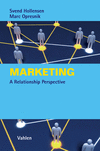Zusammenfassung
Marketing – A Relationship Perspective
Moderne Grundlange zum Marketing
Das Lehrbuch behandelt eines der wichtigsten und aktuellsten Themenfelder des modernen Marketings. Der Ansatz verbindet dabei den klassischen Ansatz der strategischen Marketingplanung und seiner Instrumente mit dem neuen Ansatz des Relationship Marketing. Der ganzheitliche Ansatz des Buches umfasst dabei die aktuellen Marketing-Grundlagen, Praxisbeispiele sowie anwendungsorientierte Fallstudien und eignet sich somit ideal sowohl für Manager und Entscheidungsträger im Marketing-Bereich, Studenten in Bachelor- und Materstudiengängen sowie Dozenten und Trainer.
- 48–57 Case 1: Nordex AG 48–57
- 96–110 2.6 SWOT Analysis 96–110
- 110–123 Case 2: BMW Motorcycles 110–123
- 226–248 4.2 Pricing Decisions 226–248
- 460–461 About the Authors 460–461
- 461–464 Index 461–464
- 464–464 Impressum 464–464

